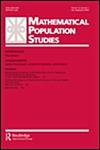Survey sampling and small-area estimation
IF 1.3
3区 社会学
Q3 DEMOGRAPHY
引用次数: 1
Abstract
This issue is devoted to survey sampling methods. It carries on a tradition of Mathematical Population Studies, after the issues guest-edited by Malay Ghosh and Tomasz Ża̧dło (2014) and Vera Toepoel and Schonlau (2017). Wright (2001) presented some major moments of the history of survey sampling. He acknowledged the pioneering work of Pierre Simon de Laplace (1878-1912; Gillispie, 1997), who estimated the population size of France in 1802 based on a sample of communes, which were administrative districts. He multiplied the population size of the sampled communes by the ratio of the recorded total number of births for the whole country to the one recorded in the sample. He used the same method to estimate the population size of France for 1782. John Graunt (1665) had also used a similar calculus to estimate the population size of England in 1662. In design-based inference, introduced by Neyman (1934), the values taken by the variable of interest are considered as fixed and the sampling design is the only source of randomness affecting the estimates. In modelbased inference, the values taken by the variable of interest are considered as the realizations of random variables. The set of conditions defining the class of this distribution is called “super-population” model (Cassel et al., 1976: 80) and inference is made conditionally on the sample, which is either drawn at random or chosen purposively from the population. Accuracy is measured only over possible realizations of the variables. In model-assisted inference, the model is used to increase accuracy, but good design-based properties, such as design consistency, are of primary interest. Various methods include calibration estimators and pseudo-empirical best linear unbiased predictors. The accuracy of the former is evaluated through randomization techniques; the accuracy of the latter through a model. In the Bayesian framework, the estimator is a conditional expectation in the posterior distribution of the population or subpopulation parameters and the posterior variance is used as a measure of the variability of the Bayesian estimator. This Bayesian technique applies to continuous, binary, and count data.调查抽样和小面积估算
本期专门讨论调查抽样方法。在Malay Ghosh和Tomasz Ża dło(2014)以及Vera Toepoel和Schonlau(2017)的客座编辑之后,它继承了数学人口研究的传统。Wright(2001)提出了调查抽样历史上的一些重要时刻。他承认皮埃尔·西蒙·德·拉普拉斯(1878-1912)的开创性工作;Gillispie, 1997),他在1802年根据公社(即行政区)的样本估计了法国的人口规模。他将抽样公社的人口规模乘以全国记录的总出生人数与样本中记录的出生人数之比。他用同样的方法估计了1782年法国的人口规模。约翰·格兰特(John Graunt, 1665)也曾用类似的方法估算过1662年英格兰的人口规模。在Neyman(1934)引入的基于设计的推理中,感兴趣的变量所取的值被认为是固定的,抽样设计是影响估计的唯一随机性来源。在基于模型的推理中,感兴趣的变量所取的值被认为是随机变量的实现。定义这种分布类别的一组条件被称为“超级总体”模型(Cassel et al., 1976: 80),并有条件地对样本进行推断,样本要么是随机抽取的,要么是有目的地从总体中选择的。准确度只能通过变量的可能实现来衡量。在模型辅助推理中,模型用于提高准确性,但良好的基于设计的属性,如设计一致性,是最重要的。各种方法包括校准估计和伪经验最佳线性无偏预测。前者的准确性通过随机化技术进行评估;后者的准确性通过一个模型。在贝叶斯框架中,估计量是总体或亚总体参数后验分布中的条件期望,后验方差被用作贝叶斯估计量可变性的度量。这种贝叶斯技术适用于连续、二进制和计数数据。
本文章由计算机程序翻译,如有差异,请以英文原文为准。
求助全文
约1分钟内获得全文
求助全文
来源期刊

Mathematical Population Studies
数学-数学跨学科应用
CiteScore
3.20
自引率
11.10%
发文量
7
审稿时长
>12 weeks
期刊介绍:
Mathematical Population Studies publishes carefully selected research papers in the mathematical and statistical study of populations. The journal is strongly interdisciplinary and invites contributions by mathematicians, demographers, (bio)statisticians, sociologists, economists, biologists, epidemiologists, actuaries, geographers, and others who are interested in the mathematical formulation of population-related questions.
The scope covers both theoretical and empirical work. Manuscripts should be sent to Manuscript central for review. The editor-in-chief has final say on the suitability for publication.
 求助内容:
求助内容: 应助结果提醒方式:
应助结果提醒方式:


